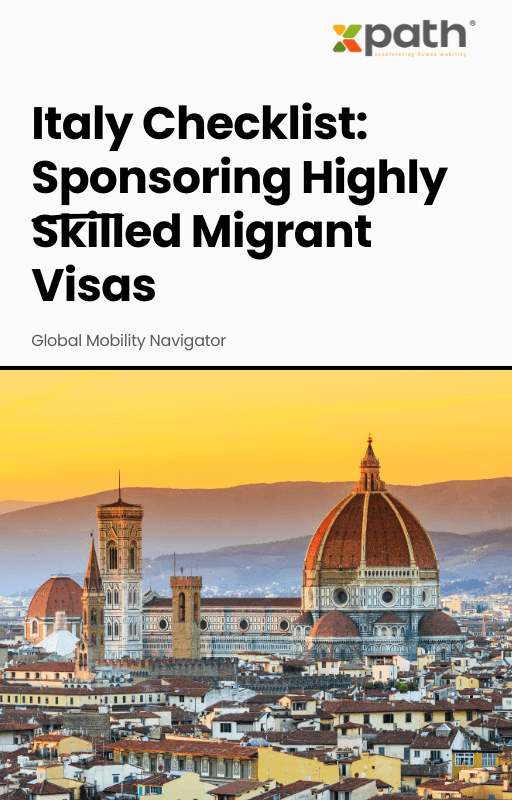Italy Checklist: Sponsoring Highly Skilled Migrant Visas
Grab a copy of a guide to international employee relocation
View E-bookAre you feeling lost and overwhelmed when it comes to developing your company’s global mobility policy? You’re not alone!
Even the most experienced HR professionals can make mistakes when it comes to navigating the complex world of international transfers.
In this article, we’re diving into some of the most common mistakes made by HR managers when drafting global mobility policies.
As an HR manager, one of the most common mistakes made when drafting a global mobility policy is failing to consider the individual needs of the transferees. Every employee is unique, with their own set of skills, experiences, and personal circumstances.
A one-size-fits-all kind of policy can lead to dissatisfaction and disengagement among employees.

For example, some employees may have young children who will need to adjust to a new school and community. Others may have elderly parents who need their support. Some employees may have special needs that must be taken into account.
Failing to consider these individual differences makes it difficult for employees to feel comfortable and productive in their new roles.
To avoid this mistake, HR managers should take a more personalized approach when drafting the global mobility policy.
For example, this can include conducting individual assessments to determine the unique needs and preferences of each employee. Afterwards, work closely with them to develop customized relocation packages that meet those needs.
This can include things like providing language and cultural training, assistance with finding housing, and support for family members.
Many HR managers focus too much on the short-term costs and benefits of an international assignment, such as relocation expenses and taxes. But they do not consider the long-term costs and benefits of the move. This can lead to high turnover rates and other problems down the road.

When developing a global mobility policy, it’s important for HR managers to look at not just the immediate costs and benefits of the move, but also at the long-term impact on the employee and the organization as a whole.
Failing to plan for the long-term can have serious consequences, including high turnover rates and other problems down the road.
One of the biggest long-term consequences of not planning for global mobility is high turnover rates. If employees are not given proper support and resources to adjust to the new location, they may become disengaged. Ultimately they may choose to leave the company.
This can be costly for the organization, as recruiting, hiring and training new employees is time-consuming and expensive. Moreover, a high turnover rate can also damage the company’s reputation in the market. In the long run, this will make it harder to attract top talent in the future.
Another long-term problem that can arise from not planning for the long-term is a lack of productivity and effectiveness among employees. If employees are not given adequate support to adjust, they may find it difficult to focus on their work.
Finally, HR managers often fail to gather relevant feedback from expatriates. They also fail to make improvements to the global mobility policy based on that feedback.

This can lead to employee dissatisfaction and a lack of trust in the process. Additionally, HR managers should also gather feedback from employees post-relocation. They should gain insights into how well the policy is working and address any issues that have arisen.
This can help to ensure that the global mobility policy is effective, efficient, and in line with the company’s strategy.
When HR managers fail to ask for feedback, they miss out on valuable insights into the employee’s experience. This can include information about what worked well during the relocation process and what didn’t.
The feedback can help the company to improve the policy and the support provided, to make the process of relocating easier and more efficient for the employee.
Incorporating feedback into the global mobility policy also helps to ensure that the policy is in line with the company’s strategy and goals. For example, if employees are consistently reporting issues with cultural barriers, HR managers can take steps to address these issues. They might provide more language and cultural training to help employees adjust better.
It’s important to note that global mobility policies should always be “work in progress”, a continuous process. As regulations and laws change it is important to revisit and update the policy on a regular basis.
An effective global mobility policy helps build a more diverse and globally-minded workforce. This can lead to a wide range of benefits such as increased creativity and innovation, as well as improved understanding and relationships with customers and partners worldwide.
Need support with drafting your global mobility policy? Get in touch with us! xpath.global is a SaaS-enabled marketplace that allows you to keep track of all ongoing assignment cases and access our +450 global mobility provider partners, with over 50.000 services in over 183 countries.

Italy Checklist: Sponsoring Highly Skilled Migrant Visas
Grab a copy of a guide to international employee relocation
View E-book